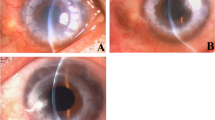Abstract
• Background: The murine model of orthotopic perforating keratoplasty is important for studying the allograft reaction, but the small dimensions cause technical difficulties. • Methods: The anterior chamber of the eye of the BALB/c mouse was measured with the confocal microscope and with histological methods. Ten C3H mouse donor corneas each were separated by the conventional technique and by the newly developed “underwater” technique, where the opened donor eye did not lose its shape under water. The corneal endothelium was stained with trypan blue and alizarin red S. Ten BALB/c (H-2d) mice received a corneal graft taken from a C3H (H-2k) mouse by the underwater technique. • Results: The 3.7-mm eye of the BALB/c mouse has a corneal diameter of 3.5 mm. The cornea has a central thickness of 170 μm, the epithelium comprising 30% and the stroma 70%. While none of the corneas separated by the new “underwater” technique evidenced endothelial damage, a 28 ± 17.0% defect of the endothelial surface was found with the conventional technique. All transplanted corneas were clear when the lids were opened on the 2 post-operative day and clouded between the 7th and 30th days (mean 16.5 days) due to an allograft reaction. • Conclusion: The newly developed “underwater” technique is superior to the conventional technique, since floating of the very thin donor cornea during the separation procedure prevents endothelial defects by guarding against folds. By enabling reliable keratoplasty in the mouse, this technique facilitates studies on the experimental allograft reaction.
Similar content being viewed by others
References
Allansmith MR, Drell D, Kajiyama G, Fine M (1976) The role of tissue typing in corneal transplantation. Mod Probl Ophthalmol 16: 167–174
Baggesen K, Ehlers N, Lamm LU (1991) HLA-DR/RFLP compatible corneal grafts. Acta Ophthalmol 69: 229–233
Batchelor JR, Casey TA, Gibbs DC, Lloyd DF, Werb A, Prasad SS, James A (1976) HLA matching and corneal grafting. Lancet 1: 551–554
Baumgartner I, Mayr WR, Hajek-Rosenmayr A, Grabner G (1988) Über den unterschiedlichen Einfluß von Inkompatibilitaten am HLA-A und HLA-B-Locus auf den Erfolg cornealer Transplantate. Klin Mbl Augenheilkd 193: 48–51
Boisjoly HM, Roy R, Dube J (1986) HLA-A, B and DR matching in corneal transplantation. Ophthalmology 93: 1290–1297
Boisjoly HM, Roy R, Bernhard P-M, Dubé I, Laughrea PA, Bazin R (1990) Association between corneal allograft reactions and HLA compatibility. Ophthalmology 97: 1689–1698
Dikstein S, Maurice DM (1972) The metabolic basis of the fluid pump in the cornea. J Physiol 221: 29–37
Edelhauser HE, van Horn DL, Hyndiuk RA, Schultz RO (1975) Intraocular irrigation solutions. Their effect on the corneal endothelium. Arch Ophthalmol 93: 648–657
Hoffmann F, Tregel N, Noske W, Bünte S (1993) HLA-B and HLA-DR match reduces the allograft reaction after keratoplasty. Ger J Ophthalmol 4: 100–104
Joo C-K, Pepose JS, Stuart PM (1995) T-cell mediated responses in a murine model of orthotopic corneal transplantation. Invest Ophthalmol Vis Sci 36:1530–1540
McCarey BE, Edelhauser HE, van Horn DL (1973) Functional and structural changes in the corneal endothelium during in vitro perfusion. Invest Ophthalmol Vis Sci 12: 410–415
Niederkorn JY, Mayhew E (1993) “Subthreshold stimulation” of allospecific delayed hypersensitivity by corneal allografts. Immunology 80: 605–610
Pepose JS, Gardner KM, Nestor MS, Foos RY, Pettit T (1985) Detection of HLA class I and II antigens in rejected human corneal allografts. Ophthalmology 92: 1480–1484
Sanfillipo F, MacQueen JM, Vaughn WK, Foulds GN (1986) Reduced graft rejection with good HLA-A and -B matching in high risk corneal transplantation. N Engl J Med 315: 29–35
Sano Y, Ksander BR, Streilein JW (1995) Fate of orthotopic corneal allografts in eyes that cannot support anterior chamber-associated immune deviation induction. Invest Ophthalmol Vis Sci 36: 2176–2185
She S-C, Steahly LP, Moticka EJ (1990) A method for performing full-thickness, orthotopic, penetrating keratoplasty in the mouse. Ophthalmic Surg 21: 781–785
Sonoda Y, Streilein JW (1992) Orthotopic corneal transplantation in mice —evidence that the immunogenic rules of rejection do not apply. Transplantation 54: 694–704
Sonoda Y, Streilein JW (1993) Impaired cell-mediated immunity in mice bearing healthy orthotopic corneal allografts. J Immunol 150: 1727–1734
Sonoda Y, Sano Y, Ksander B, Streilein JW (1995) Characterisation of cell-mediated immune responses elicitated by orthotopic corneal allografts in mice. Invest Ophthalmol Vis Sci 36:427–434
Taylor MJ, Hunt CJ (1981) Dual staining of corneal endothelium with trypan blue and alizarin red: importance of pH for the dye-lake reaction. Br J Ophthalmol 65: 815–819
The Collaborative Corneal Transplantation Study (CCTS) (1992) Effectiveness of histocompatibility matching in high-risk corneal transplantation. Arch Ophthalmol 110: 1392–1403
Treseler PA, Foulks GN, Sanfillipo F (1984) The expression of HLA antigens by cells in the human cornea. Am J Ophthalmol 98: 763–772
Tripathi BJ, Tripathi RC, Wong P, Raja S (1990) Expression of HLA by the human trabecular meshwork and corneal endothelium. Exp Eye Res 51: 269–276
Vannas S (1975) Histocompatibility in corneal grafting. Invest Ophthalmol Vis Sci 14: 883–886
Völker-Dieben HJ, Kok van Alphen CC, Lansbergen Q, Persijn GG (1982) The effect of prospective HLA-A and-B matching on corneal graft survival. Acta Ophthalmol (Copenh) 60: 203–212
Wiederholt M, Koch M (1979) The effect of intraocular irrigating solutions on intracellular membrane potentials and swelling rate of isolated human and rabbit cornea. Invest Ophthalmol Vis Sci 18: 313–317
Yao YF, Inoue Y, Miyazaki D, Shimomura Y, Ohashi Y, Tano Y (1995) Ocular resurfacing and alloepithelial rejection in a murine keratoepitheliopathy model. Invest Ophthalmol Vis Sci 36:2623–2633
Young E, Stark WJ, Prendergast RA (1985) Immunology of corneal allograft rejection: HLA-DR antigens on human corneal cells. Invest Ophthalmol Vis Sci 26: 571–574
Author information
Authors and Affiliations
Rights and permissions
About this article
Cite this article
Zhang, EP., Schründer, S. & Hoffmann, F. Orthotopic corneal transplantation in the mouse — a new surgical technique with minimal endothelial cell loss. Graefe's Arch Clin Exp Ophthalmol 234, 714–719 (1996). https://doi.org/10.1007/BF00292359
Received:
Revised:
Accepted:
Issue Date:
DOI: https://doi.org/10.1007/BF00292359



